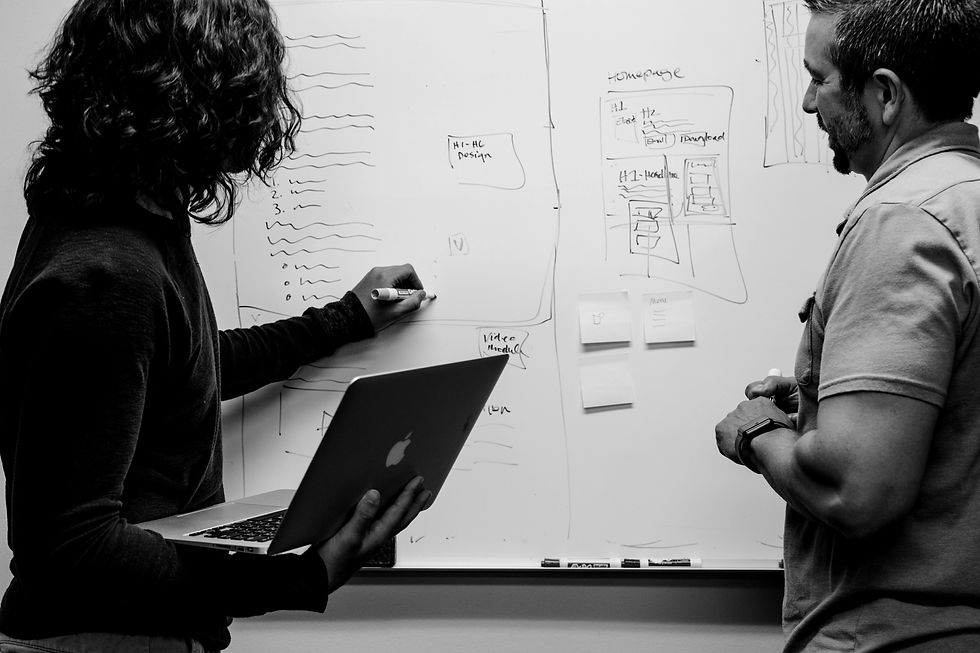Digital capabilities - a snapshot of sector approaches
- John Melton

- May 13, 2024
- 4 min read
Updated: Aug 7, 2024
By Emma Bayne, Principal Consultant; and Amber Kirkbride, Senior Consultant / 13 May 2024

Digital Underpins Almost Everything
It’s hard to identify aspects of our day-to-day lives that aren’t facilitated in some way by digital technology. This, together with the rapid pace of change, means universities are facing unprecedented challenges to modernise their infrastructure, upskill their staff and meet the expectations of increasingly digitally-savvy students. We’ve been digging into what this means for higher education, undertaking desk-based research to see what universities are doing to nurture digital capability and adoption, building our understanding of best practice and where universities are in developing this critical skill set.
We've found examples of best practice in how digital capabilities are deployed across the sector against the following themes:
Transforming services and experiences
Learning and development
Digital-first culture
Openness, empathy and inclusion
Professional futures and employability
Transforming Services and Experiences
Digital is transforming staff and student experiences. With the digitalisation of processes, self-serve for simpler, transactional interactions is becoming normalised. Experiences are made in those critical, high-impact service moments where digital is the understudy to irreplaceable human interaction and care. Utilising digital and automating processes has the potential to support a culture of wellbeing and belonging; enhancing experiences to feel considered, included and valued. Case study: Enhancing Student Belonging – University of Nottingham (Strive)
Collaborating with students, many of whom identify as Gen Z and are digital natives, is a great way to push boundaries and get fresh perspectives on emerging digital capabilities such as AI. This example from University of Arts London is a great demonstration of this in action: UAL Creative Hack.

SPOTLIGHT: Student recruitment and enrolment is one of the biggest challenges an institution faces. With the financial sustainability of universities under increasing pressure, deploying digital capabilities to improve efficiency and effectiveness can bring great benefits. Proactive, data-driven, digital approaches enable automation and allow teams to focus on high value activity to deliver more personalised outcomes. Durham University shows how they used AI to do just that. Case study: Durham University Student recruitment-AI
Learning and Development
Digital competencies like data literacy, technology enhanced learning and online safety are part of everyday life. The constant evolution of digital skills makes it challenging to find the right resources and know where to focus your efforts. Digital competency frameworks are commonplace across higher education; from leadership behaviour to learning and teaching, assessments, research methodology and analysis-enhancing tools. Our research found these frameworks help embed a digital culture and emphasise how important it is; especially so when they are applied through practical tools to support staff learning and development. The DigiCentre at University of Wales showcases how you can support staff and students in this space.
Digital-first Culture
Embracing a digital-first culture is about the behaviours, mindsets and values individuals hold. A big challenge in HE is retaining staff once they have built their knowledge and expertise. Our research shows this comes down to positive culture, values alignment and empowerment.
Placing rising value on collaboration, a fail-fast and learn faster mindset and innovation which pushes boundaries, can be challenging in a sector with many different regulatory requirements. Combined with real-time data reporting and data driven decisions, collaboration, innovation and culture have been identified as key agility enablers in our recent insights.

SPOTLIGHT: It’s not just staff who need to build digital capability, but students too. With increasing digital poverty, it is important that Universities provide spaces and technology for students who need it. This video about the Digital Reading Room at University of Leicester shows how they approached it and why it’s important.
Openness, Empathy and Inclusion
Openness, empathy and inclusion are the threads that sit at the heart of making digital capability work, as well as being core to culture. Digital capability supports an operating model designed with your users in mind and encourages new ways to approach challenges. It’s important alongside this to support underrepresented students and staff who may need to adapt their roles to the changes.
The digital tools we use play a big part in this so considering empathy and inclusion through the selection of digital tools is essential. Microsoft explain their cultural shift over the past few years in this article.
Professional Futures and Employability
A core part of the learning experience is the transition from education into employment. Many universities provide support for this, such as Warwick University’s Student Opportunity portal.
There is no likely future of work in which digital doesn’t play its part. Immersive experiences, like AR and VR, continue to shape how we prepare talent for the workplace and AI applications are becoming ever more present in industry. Individual expectations on what it means to ‘go to work’ have seen a seismic shift since the pandemic and the global work/learn from anywhere trend is increasingly prevalent. Our professional futures have never been more dependent on digital capability and our ability to adapt to innovations.
Conclusion
Maturing digital capabilities and finding ways to use emerging technology is fundamental for future-proofing higher education. Best practice today will be superseded by best practice tomorrow.
This initial exploration is the start of a conversation series that we will deliver on digital capability in higher education. Over the coming months we will be shaping opportunities for individuals and institutions across the sector to contribute thought-provoking and leading perspectives on how the sector can continue to operate at the forefront of digital possibility.
If you’re interested in having a conversation with us about your digital capabilities, transformational change or learning and development needs, get in touch.



